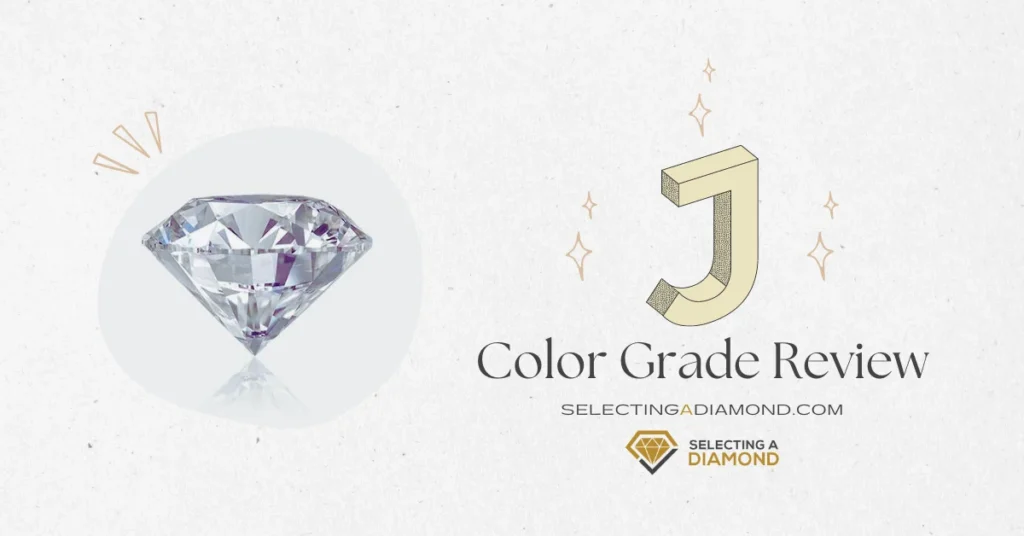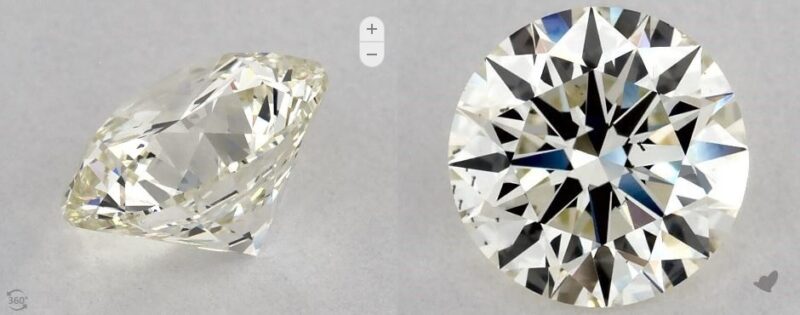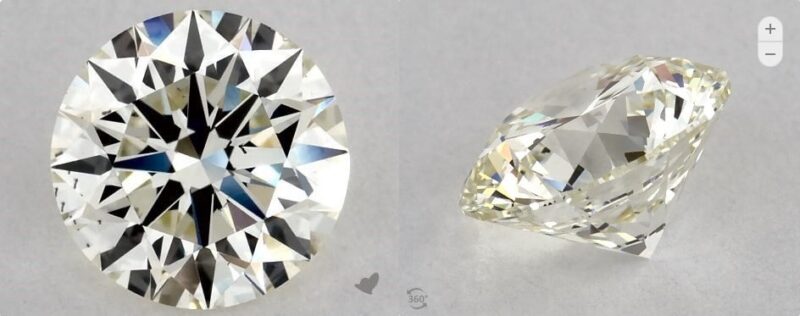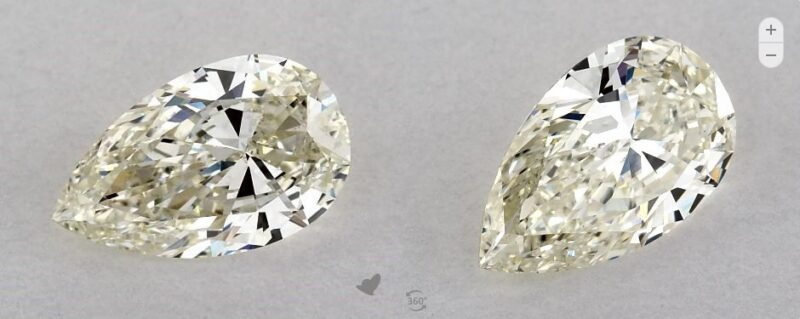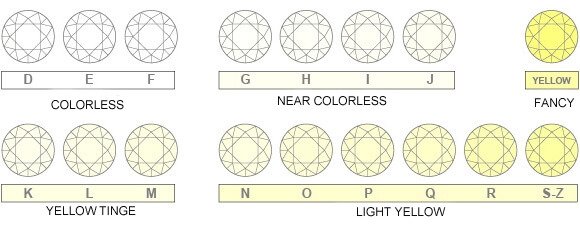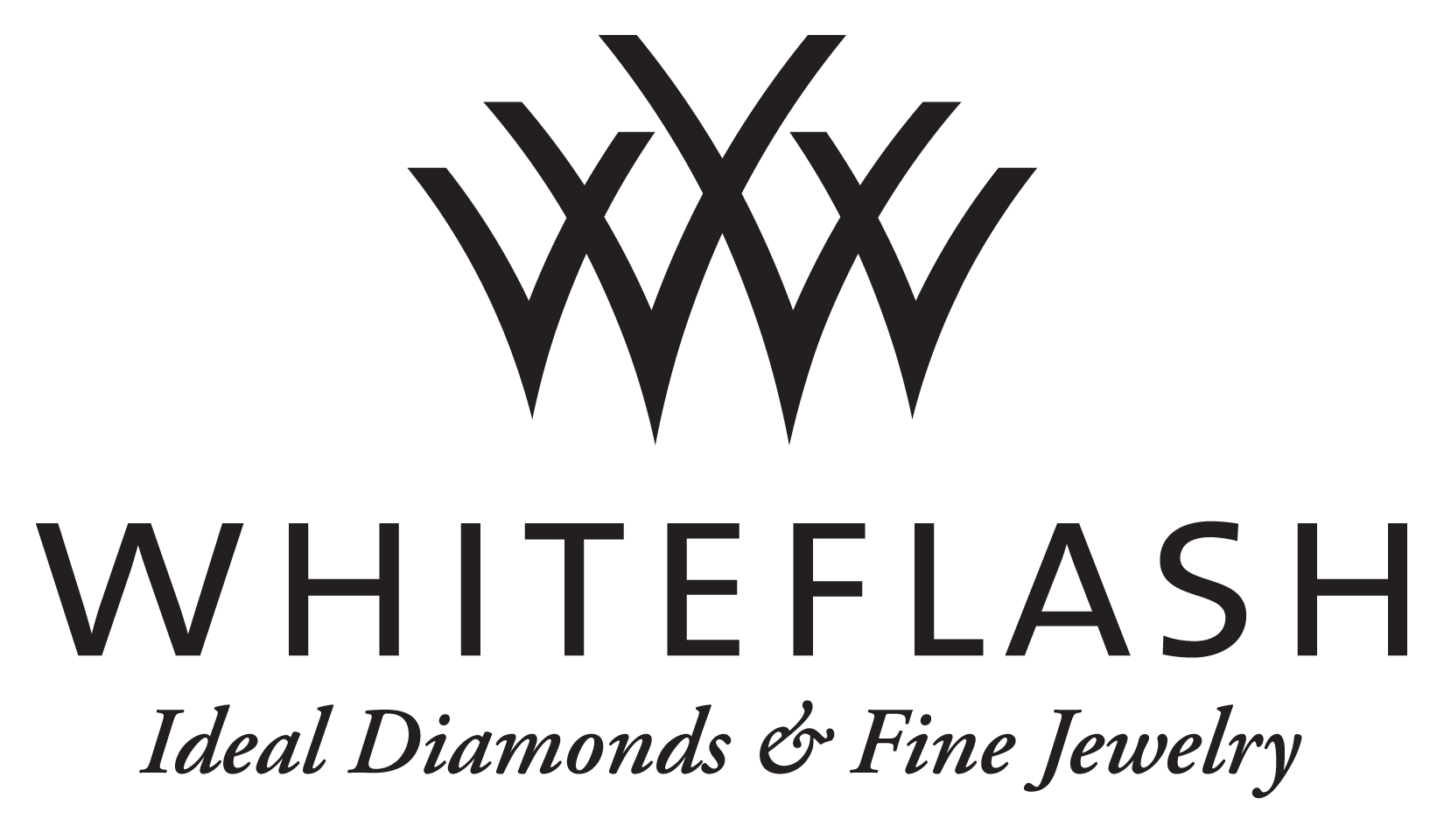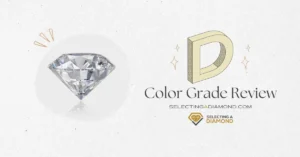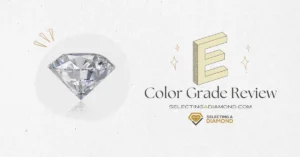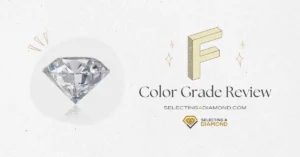We may earn a commission when you purchase through our affiliate links, at no extra cost to you. This helps support our work and allows us to continue providing unbiased, expert diamond advice.
A bit far from the colorless group, and sits at the edge of the near colorless group for diamond color grades.
What are J color grade diamonds? Are they good? Yellow/colorless to the eye?
That’s what we will see in this review for J color grade diamonds, so you can make an informed decision next time you’re in the market to get a diamond.
We will go over their color intensity, price range, how they compare to similar grades like the I color grade, and understand when you are safe to get one (and when you should NOT).
Before we start, we think it will be a good idea to see how an actual J color grade diamond look like, and because static images don’t represent the actual color (specially in round shape), here are 2 images for this J color diamond on James Allen:
No wonder why the round shape is the most popular diamond shape, it hides color (by reflecting light) like magic.
What is the J Color Grade?
The J color grade for diamonds is the last letter/grade of the near-colorless group, which is a group that most people prefer to search for their precious stone from because of its affordability.
One of the differences between colorless & near colorless groups are number of grades in each group, which reflects on the visible difference between first & last grade in that group, i.e. the difference between D & F colors (being in colors group) is less than what’s between G & J (near colorless group).
James Allen defines J color the same they do for I color:
These diamonds have slight color, which tends to be more visible in diamonds over 1 carat.
Blue Nile defines J color grade on their education page as:
A good value, the naked eye can’t easily detect the light yellow tone unless compared side-by-side with diamonds of I grades or higher. J color grade diamonds pair well with yellow gold ring settings.
So, in a nutshell, J color offers a good value for the money, it’s not pure as G color grade for example, but still considered in the near colorless group, and tends to hide yellow color (specially on round shape) when inspected by naked eye.
This becomes harder for smaller diamonds (less than 1 carat).
Similar to I color, a diamond with J color grade will have some yellow tint in 2 conditions:
- Compared side by side by a higher color grade.
- Diamond is relatively large, i.e. more than 1 carat.
So in other words, looking with your own eyes without a reference diamond (with higher color) at a relatively small diamond won’t tell you anything about its color.
And just a reminder, while seeing a yellow tint in the diamond isn’t desirable for most people, it’s not necessary to go extremely high grade like E color to guarantee a colorless diamond, as we’ve explained in our guide on what diamond 4Cs to get.
J Color in Different Diamond Shapes
Keep in mind 1 thing, different diamond shapes have different visible levels of yellow color, i.e. a J color round shape diamond will not appear as yellow as pear shaped diamonds.
Check for example how round shape diamond look when viewed from top (left image), versus how it looks if inspected from a different angle (right), the 2 images are for the SAME diamond, it has excellent cut & VS2 clarity grade:
A diamond with very similar characteristics but with a pear shape looks much more yellow, even when viewed from top:
That’s why it’s important to learn more about the most popular shapes of diamonds and understand how each shape affects light reflection and total appearance.
Where J Color Grade Stands in Diamonds Color Chart?
The global standard of diamond color grading is set by GIA, they created a color grading chart that divides diamonds into groups, each group contains several grades.
J color sets comfortably at the end of the near colorless range (G,H,I, and J), and in order of colorlessness, it’s the 7th from the purist color: The D color grade, here is a representation of the GIA color grading:
Being on the edge of the group, it’s considered the least favorite option for people who want a diamond without any visible color under any conditions, since it’s very close (actually 1 grade away) from the yellow tinge group, as per the GIA chart.
If you are interested to know more about this grading structure, we encourage you to go over our diamond color guide to have a better understanding of how this was built.
Besides what’s written above, it’s crucial to know that near colorless diamonds are different, and because they have 4 grades, the differences between G & J are easily visible to the naked eye.
In our H color grade review, we learned why it’s a great starting point in diamond color for anyone, and in the I color grade review, we knew how to take it with a grain of salt.
The same goes for J as well, you have to be careful picking a J color diamond if you’re going with a large diamond, or putting the rock on a white gold or platinum setting, since the diamond will show some yellow tint in contrast to the purity of white & platinum ring.
On the other hand, J color might be a good choice if you’re going a rose gold or a yellow gold setting, that’s because the ring will definitely carry its color to the stone, even if you’re getting high grades like D color diamonds.
J & Neighboring Colors: I vs J vs K Grade Difference
By now, we know for a fact that the difference between 2 adjacent colors is so minimal that you can’t detect it with your own eyes.
James Allen says that the visual difference between each color grade and the next one is very hard to detect, in their words:
Generally, when comparing color between two diamonds, the diamonds need to be at least two color grades apart to even begin to see a difference
For the J color, it would be hard to differentiate it from I & K, but the I vs K color difference will be easier to detect.
To put this in perspective, let’s look at 3 images for 3 different diamonds, from I, J, and K color grades.
Visual Comparison
First things first, it’s essential to know that looking at loose diamonds is different from checking them while set on a ring.
The same goes for “static” images vs rotating ones, when you compare 2 diamonds online, you should be able to see them BOTH in 360 degree, as it won’t be a fair comparison checking a round shape diamond from store A that shows static image, vs another round shape on James Allen (store B) which offers 40x HD 360 degree images for their inventory.
We will be using round shape diamonds in our comparison to show the I vs J vs K color difference, since it’s the most popular shape among all others.
Here are 3 images for the I grade and its adjacent colors as well, taken from James Allen:
And because this angle doesn’t reflect the right amount of color in a diamond, here are the exact same 3 diamonds, with screenshots from different angles:
Color is clearer now right?
That’s why we always recommend checking diamonds in 360 degrees and don’t just stop at the static images to understand how diamond interacts with light.
For reference, here is the I color, this is the J grade diamond, and lastly this is the K color diamond.
We also suggest you check what Whiteflash – the house of premium cut diamonds – imaging technology reveals, they offer great 360 images for their inhouse diamonds.
Is J Color Grade Recommended/Good to Buy?
Generally speaking, if you’re a fan of purely colorless diamond, J (and even I) color diamonds aren’t your favorite options, this is also applicable in these cases:
- The diamond you’re looking for is large, more than 1 carat (be careful, if her hands are small, you better see actual size on fingers to make a wise decision on carat).
- If you want to put the diamond in a platinum or white gold ring, the J color will be visible as a contrast of the pure white of the ring.
- You’re getting a shape other than brilliant, like cushion, oval, pear, or marquise, these shapes don’t reflect light like round shaped diamonds, leaving the diamond color itself more visible.
In less common cases, it might be useful to consider a J color stone, like:
- Getting a small diamond, like half a carat, especially if it’s a round-shaped diamond and has excellent cut, the size & shape will play it well to hide the color of the diamond.
- Interested in rose gold or yellow gold setting, again, especially if the diamond is small, the color will be carried from ring to diamond, regardless how colorless the diamond is.
- The diamond has faint or medium blue fluorescence, this level of fluorescence can help in making the diamond a little whiter.
- Your budget allows you to get J color and not higher, don’t overspend and get into debt just to go 1 or 2 levels higher, the color is a matter of taste at the end, opt in for a smaller diamond and you will be safe.
J Color Diamonds Pricing
In our review for the average 1 carat diamond price, we used H & G colors as reference and standard grades you should start your diamond search from.
J is 2 levels down from H color (or 3 to G), so these diamonds will be much cheaper than the average price we discussed.
As we know, diamond pricing is affected by many factors, and to estimate how much J color diamonds are worth, we need to fix the main diamond characteristics and other less (but important) factors, like fluorescence, table & depth, symmetry, etc.
Here are the fixed characteristics we will use to find the average J color diamonds prices:
Cut: Excellent
Clarity: VS2
Carat: 1
Shape: Round
Polish & Symmetry: Excellent
Fluorescence: None
Now, running this search on James Allen to get the prices (since they have hundreds of thousands of diamonds so it would be a fair estimation), we find these:
We found 73 diamonds, with the average price for J color diamonds between $3200 to $5000, around $1.5k cheaper than the average price of an H diamond with similar characteristics.
The price difference between each color grade doesn’t usually exceed $500, but here, the $1500 for 2 levels is because H color is considered the last “safe” color to get, and people prefer not to go lower than it, but as we saw above, sometimes it won’t matter and you can save yourself and make a wiser decision (probably to get a higher cut?).
Running the exact same search on Blue Nile gave us similar results, prices range between $3300 and $4900.
Summary
Whether looking for an engagement ring or just any diamond, understanding what factors affect a diamond’s beauty and how each one affects price is essential.
To ensure a glittering and exquisite stone, it’s even more crucial to know how high in grade you must go and not surpass (whether for cut, clarity, or color).
In colors, the choice of a diamond’s color ultimately comes down to taste. While some people want a clear and colorless grade, others prefer their gemstones to have some color.
In some situations, as we saw above, choosing an J color diamond might be a wise decision. It’s not always necessary to go higher (or crazy) in color grades.
In other words, always work toward a high cut grade first because it follows the 4Cs in priority, and then (and only then) should you begin examining other variables.
Start with a SI1 for clarity if you’re buying a diamond that weighs one carat or less; in most cases, SI1 clarity grade will be eye-clean.
We always recommend shopping diamonds online and created a Full guide to shop diamonds like a Pro.
Our favorite online store, best diamond imaging technology available today, comes with the largest collection with more than half a million loose diamonds.
Widest collection of loose diamonds of all sizes, great imaging technology for most of their inventory (hundreds of thousands of diamonds), great customer support.
Home Of A CUT ABOVE® Super Ideal Diamonds, they stand out from the crowd by offering premium diamonds cuts, tailored to those who love the details, at great prices too.
Still not sure where to buy your diamond?
Among online retailers, here are our favorite stores click their logo to visit store

